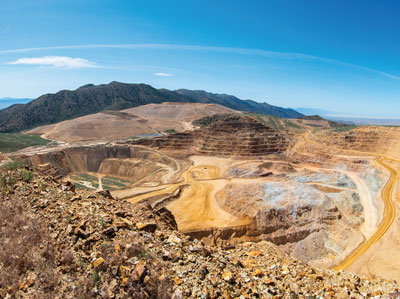Conditions are ripe for an accelerated transition to electric vehicle use in the United States. The Biden-Harris administration has set a target that 50 percent of newly purchased cars in 2030 be electric. In addition, the Inflation Reduction Act of 2022 provides significant tax incentives for purchasing electric vehicles and for companies that produce them.
And that is good news for environmental justice (EJ), says Lisa Benjamin, author of a paper called “EVs as EJ?” forthcoming in Harvard Environment Law Review. Benjamin, associate professor of law at Lewis & Clark Law School, details all of the positive impacts of EVs on environmental justice pursuits. But she also outlines the potential harm that could be done to Native communities without updated mining regulations and greater inclusion in land-use decision-making.
The reason? The increase in electric vehicle production is being accompanied by an increase in domestic mining for the minerals included in EV batteries. Many of these minerals, such as lithium and cobalt, are located in or near tribal lands, including sacred and culturally important sites.
Widespread adoption of EVs is critical to reducing carbon and other greenhouse gas emissions, a key driver of climate change. The transportation sector is the largest source of U.S. carbon emissions. According to the United Nations’ Intergovernmental Panel on Climate Change (IPCC), a 50 percent reduction in carbon must be achieved by 2050—and as much as a 91 percent decrease by 2100—to stay within the globally accepted goal of limiting the planet’s warming to 1.5 degrees Celsius. The rapid adoption of electric vehicles is poised to play a major role in this reduction.
As Benjamin explains, a reduction in gas-powered cars will be especially beneficial to communities of color and/or low-income communities who have been disproportionately harmed by environmental burdens.
“Because of discriminatory policies, highways were built near and through Black and brown communities, making these communities much more vulnerable to chronic illnesses like heart disease and diabetes through exposure to air pollution,” says Benjamin, whose work focuses on climate justice and climate risk as well as how these issues intersect with energy law and administrative law.
In addition, says Benjamin, cost barriers and the lack of availability of charging stations and other infrastructure are preventing wider adoption of EVs by lower-income families.
“EVs are not affordable, and they have to be more affordable if we are going to provide economic justice for communities who have been discriminated against,” says Benjamin.
Despite all of the ways that greater adoption of electric vehicle use is making a positive difference, there are potential negative impacts.
According to a White House fact sheet, the clean energy transition is expected to drive up global demand for key minerals essential for EV batteries, such as lithium, graphite, cobalt, and nickel by 400 to 600 percent.
“Imperial Valley in California has one of the largest deposits of lithium in the world. There are also deposits in Oregon, Nevada, North Dakota, Tennessee, and Arkansas. The vast majority of nickel, copper, and lithium are located within 35 miles of Indian reservations. …,” writes Benjamin.
“The deposits happen to be either in or really near tribal lands from reservations,” says Benjamin.
In order to prevent further harm to Native communities, Benjamin urges the Bureau of Land Management to adopt stricter requirements prohibiting mining not only at sacred sites on reservations but also in any adjacent areas deemed culturally important. One area of focus is an update to the 1872 General Mining Act which, writes Benjamin, was “passed during a period of exploration and exploitation of the American West.”
“If the regulations are reimplemented, or redrafted, that could lead to more consultation with tribes,” says Benjamin. “This is especially important in areas that may be off-reservation but still of cultural importance to tribal communities to ensure that their interests are fully taken into account when people mine for those materials.”
Benjamin also recommends that BLM strengthen their process for including Native communities in the agency’s decision-making procedures.
While Benjamin acknowledges that the transition to greater electric vehicle use is important for achieving climate and environmental justice goals for a number of disadvantaged communities, she says it’s important to ask: “How do we make sure that the transition not only provides benefits for these communities but also does not further disadvantage them?”

